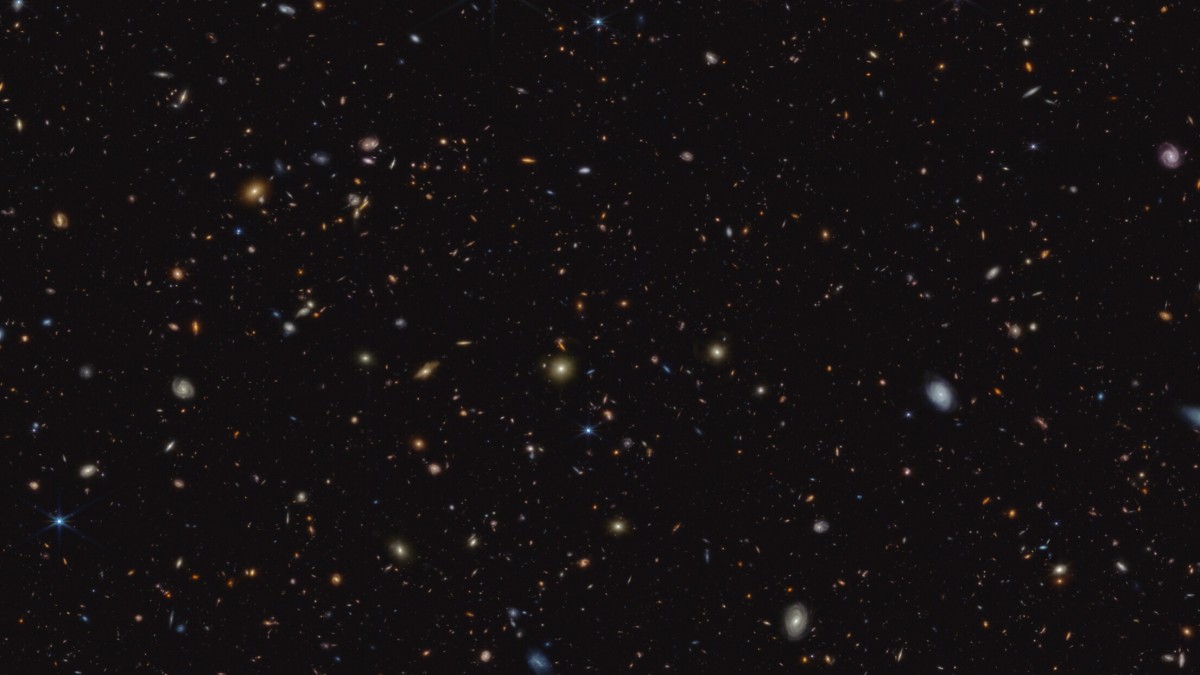Cosmic signal from the very early universe will help astronomers detect the first stars
Understanding how the Universe transitioned from darkness to light with the formation of the first stars and galaxies is a key turning point in its development known as the Cosmic Dawn. However, even the most powerful telescopes can’t directly observe these earliest stars, so determining their properties is one of the biggest challenges in astronomy.

The image shows a deep galaxy field, featuring thousands of galaxies of various shapes and sizes.
However, an international group of astronomers, including Dr Robert Izzard from the University of Surrey, have shown that we will be able to learn about the masses of the earliest stars by studying a specific radio signal – created by hydrogen atoms filling the gaps between star-forming regions – originating just a hundred million years after the Big Bang.
By studying how the first stars and their remnants affected this signal, called the 21-centimetre signal, the researchers have shown that future radio telescopes will help us understand the very early Universe, and how it transformed from a nearly homogeneous mass of mostly hydrogen to the incredible complexity we see today. Their results are reported in the journal Nature Astronomy.
This is a unique opportunity to learn how the Universe’s first light emerged from the darkness. The transition from a cold, dark universe to one filled with stars is a story we’re only beginning to understand.Professor Anastasia Fialkov from Cambridge’s Institute of Astronomy, which led the study.
The study of the Universe’s most ancient stars hinges on the faint glow of the 21-centimetre signal, a subtle energy signal from over 13 billion years ago. This signal, influenced by the radiation from early stars and black holes, provides a rare window into the Universe’s infancy. The insights gained are derived from simulations that integrate the primordial conditions of the Universe, such as the hydrogen-helium composition produced by the Big Bang.
In developing their theoretical model, the researchers studied how the 21-centimetre signal reacts to the mass distribution of the first stars, known as Population III stars. They found that previous studies have underestimated this connection as they did not account for the number and brightness of X-ray binaries – binary systems made of a normal star and a collapsed star – among Population III stars, and how they affect the 21-centimetre signal. Dr Robert Izzard, of the University of Surrey, provided the binary c stellar modelling framework used to simulate these exotic stellar systems and quantitatively estimate their 21 cm emission.
It takes a bit of imagination to connect radio data to the story of the first stars, but the implications are profound.Fialkov added.
The predictions we are reporting have huge implications for our understanding of the nature of the very first stars in the Universe. We show evidence that our radio telescopes can tell us details about the mass of those first stars and how these early lights may have been very different from today’s stars.Dr Eloy de Lera Acedo, Principal Investigator of the REACH telescope and PI at Cambridge of the SKA development activities.
The research was supported in part by the Science and Technology Facilities Council (STFC), part of UK Research and Innovation (UKRI).
###
Notes to editors
- Dr Robert Izzard is available for interview; please contact mediarelations@surrey.ac.uk to arrange.
- The full paper is available at https://www.nature.com/articles/s41550-025-02575-x
- Full image credit: ESA/Webb, NASA, ESA, CSA, B. Robertson (UC Santa Cruz), B. Johnson (Center for Astrophysics, Harvard & Smithsonian), S. Tacchella (University of Cambridge, M. Rieke (Univ. of Arizona), D. Eisenstein (Center for Astrophysics, Harvard & Smithsonian), A. Pagan (STScI)
Media Contacts
External Communications and PR team
Phone: +44 (0)1483 684380 / 688914 / 684378
Email: mediarelations@surrey.ac.uk
Out of hours: +44 (0)7773 479911
